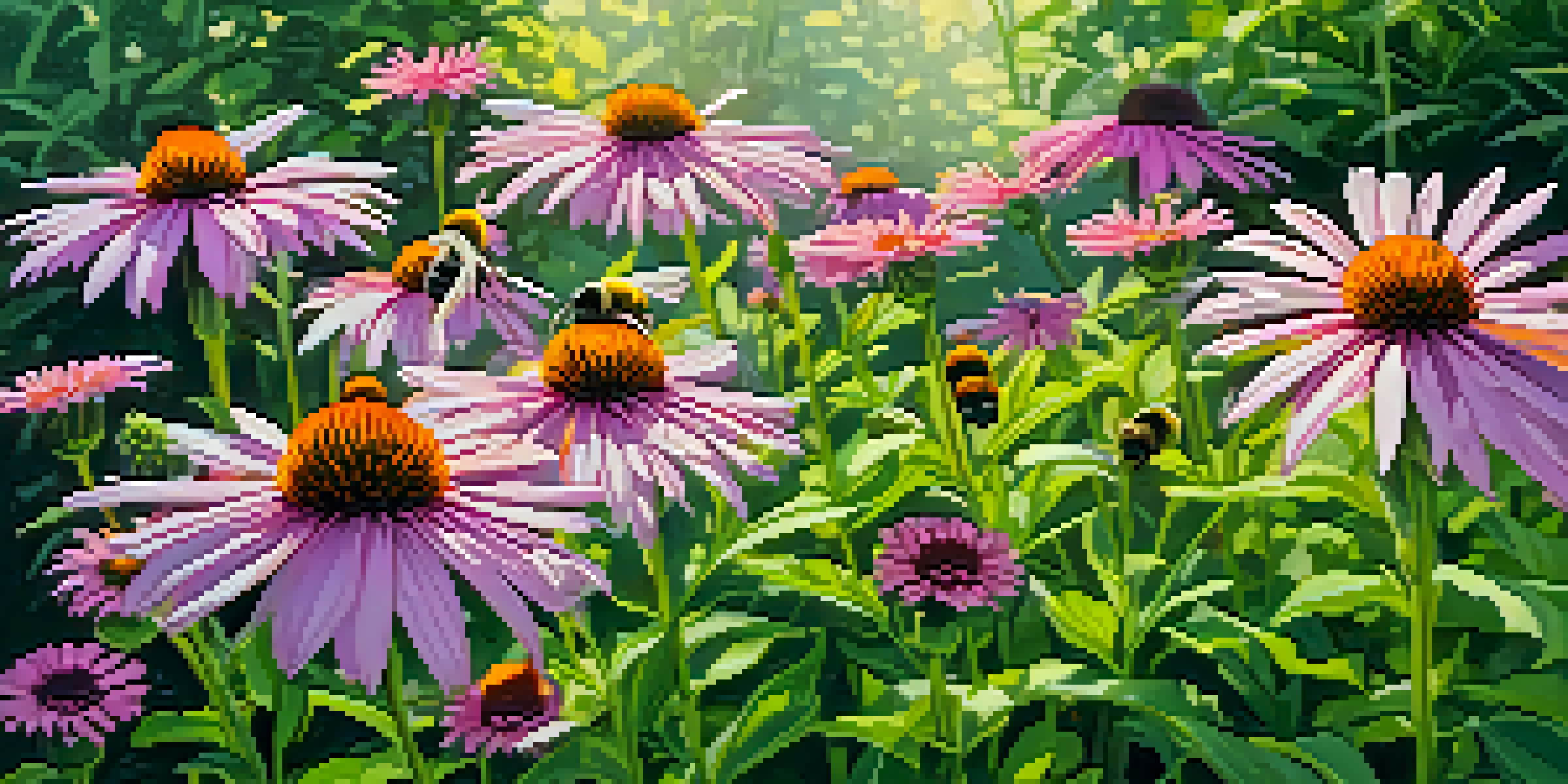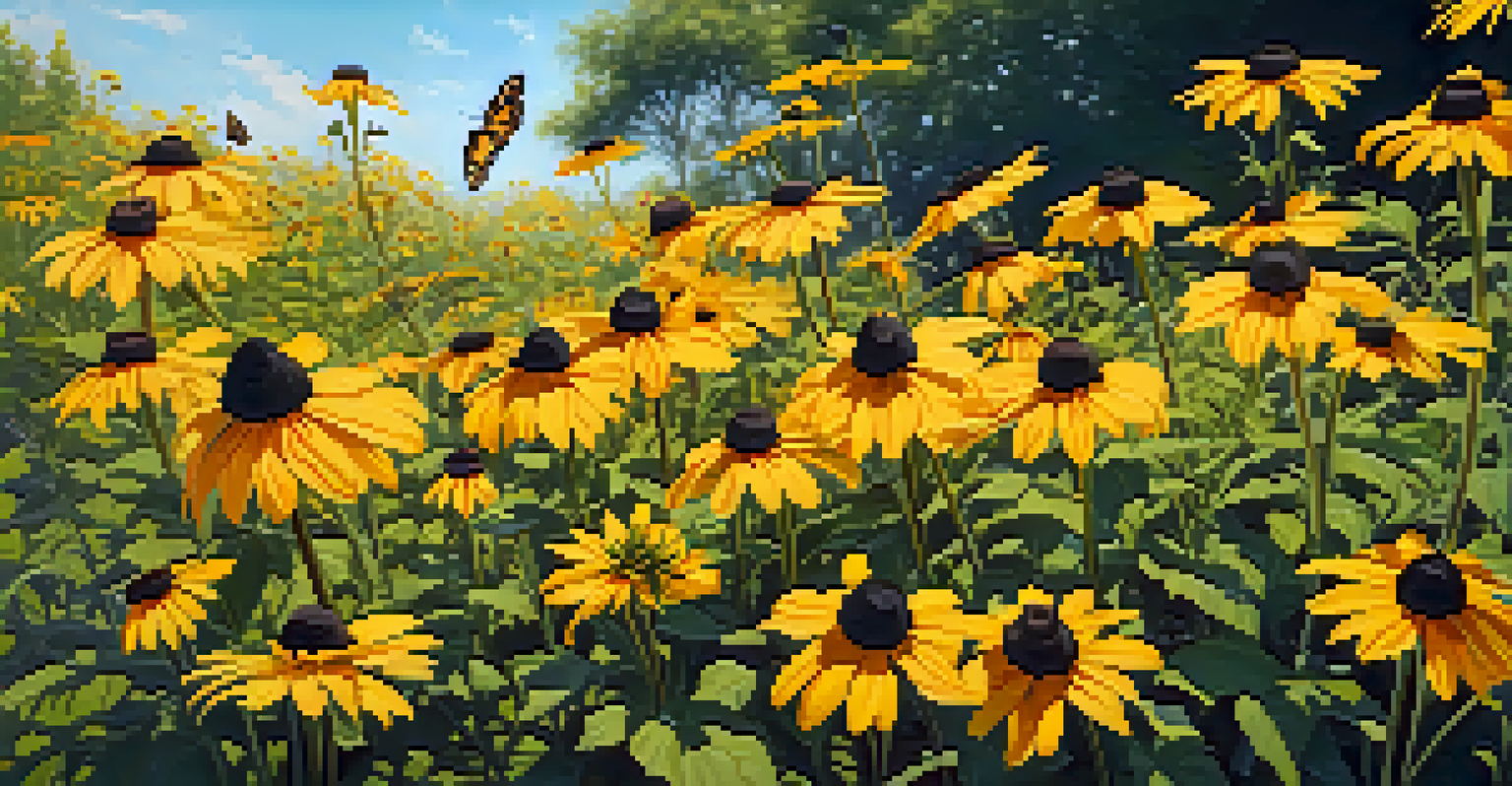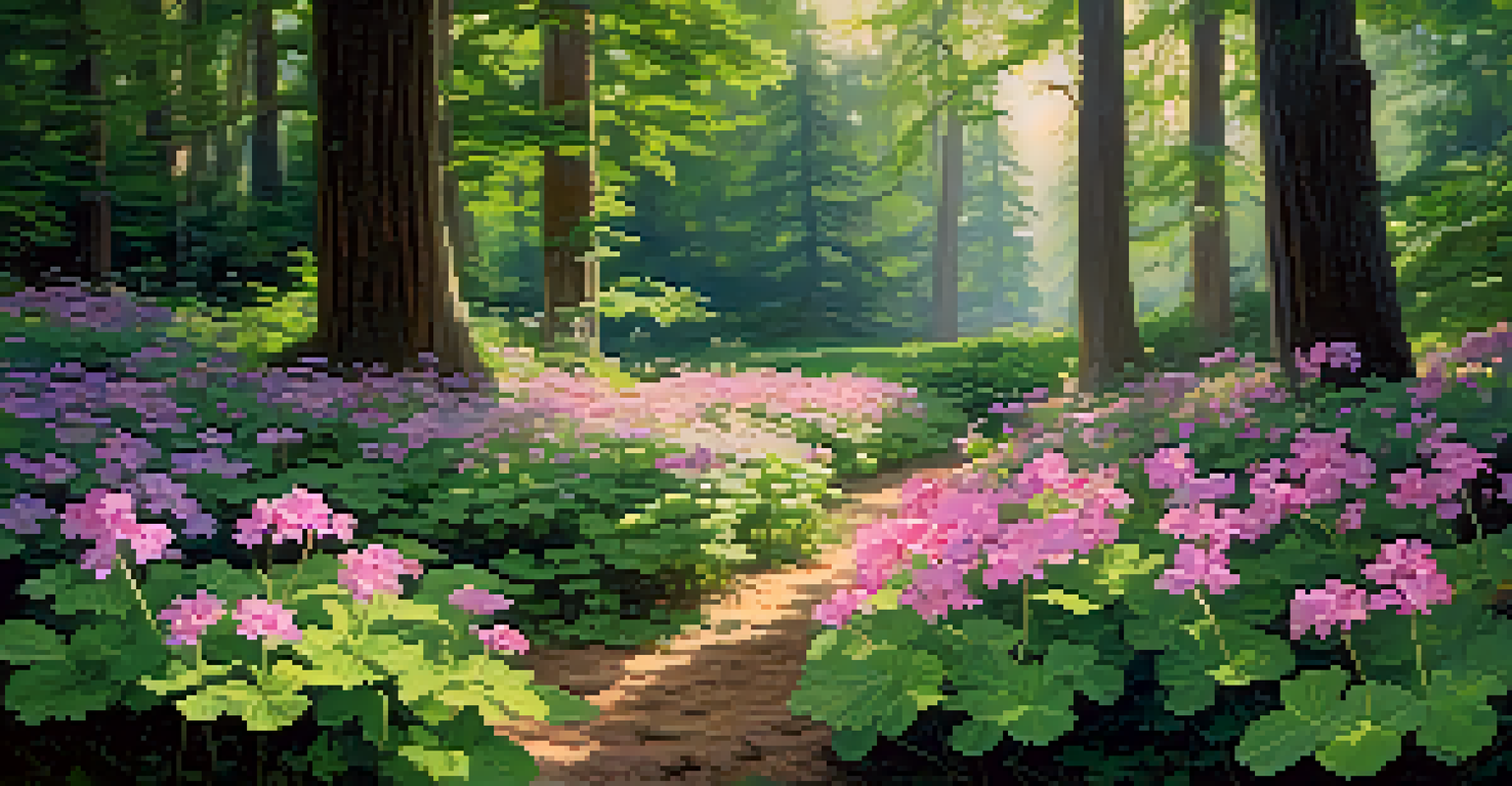Top 10 Native Plants for Sustainable Landscape Design

Why Choose Native Plants for Your Landscape?
Native plants are adapted to the local climate and soil conditions, making them easier to grow and maintain. By choosing these plants, you can create a landscape that thrives naturally with minimal intervention. This not only saves you time and effort but also helps conserve water, as native plants often require less irrigation once established.
The greatest threat to our planet is the belief that someone else will save it.
Another significant advantage is the support native plants provide to local wildlife. These plants are crucial for pollinators like bees and butterflies, as they offer the right food and habitat. A landscape filled with native flora can transform your yard into a vibrant ecosystem that benefits both nature and your enjoyment.
Moreover, embracing native plants contributes to biodiversity. By planting a variety of species, you help maintain healthy ecosystems, which can combat pests and diseases. This holistic approach to landscaping fosters resilience and sustainability in your outdoor spaces.
1. Purple Coneflower: A Pollinator Magnet
The Purple Coneflower, or Echinacea purpurea, is a stunning addition to any garden, boasting bright, daisy-like flowers. This plant is not only visually appealing but also serves as a vital source of nectar for bees and butterflies. With its ability to thrive in various soil types and exposure levels, it’s a versatile choice for different landscaping needs.

Apart from its beauty, the Purple Coneflower is drought-resistant, making it an excellent option for sustainable gardens. Its long bloom time, lasting from summer into fall, ensures that your garden remains vibrant for months. Plus, the seeds it produces are a favorite snack for birds during the winter months.
Native Plants Enhance Your Landscape
Choosing native plants leads to a thriving landscape that requires minimal maintenance and conserves water.
Incorporating Purple Coneflowers into your landscape design can also add a touch of ruggedness, as they require minimal maintenance. With a little planning, you can create a visually striking garden that supports local wildlife while minimizing water usage.
2. Black-eyed Susan: A Sunny Delight
Black-eyed Susan, known scientifically as Rudbeckia hirta, is a cheerful flower that brings warmth and brightness to landscapes. Its golden yellow petals and dark centers are instantly recognizable, making it a popular choice for gardens. These native beauties bloom from mid-summer to fall, ensuring a splash of color during the warm months.
Planting trees is like putting money in the bank.
These hardy plants are not only beautiful but also resilient, thriving in a variety of soil conditions and tolerating drought. This makes them an ideal choice for low-maintenance gardening. They also attract a range of pollinators, contributing to a healthy ecosystem right in your backyard.
Planting Black-eyed Susans in clusters can create a striking visual impact, enhancing your landscape design. Their ability to self-seed means they can spread naturally, adding to the sustainability of your garden as they continue to thrive with minimal intervention.
3. Wild Bergamot: A Fragrant Oasis
Wild Bergamot, or Monarda fistulosa, is a fragrant herb that can be a delightful addition to your garden. Known for its stunning lavender blooms, this plant not only adds beauty but also offers a lovely aroma that attracts bees and butterflies. It thrives in full sun and well-drained soil, making it easy to care for in various landscaping setups.
This native plant is also valued for its medicinal properties, historically used by Indigenous peoples for various ailments. Beyond its practical uses, Wild Bergamot is a fantastic choice for pollinator gardens, as it produces nectar-rich flowers that support local wildlife.
Support Local Wildlife with Flora
Native plants provide essential food and habitats for pollinators and other wildlife, fostering a vibrant ecosystem.
Incorporating Wild Bergamot into your landscape can enhance biodiversity while providing visual and sensory appeal. Its resilience to drought and pests makes it a sustainable choice that requires little care, allowing you to enjoy your garden without excessive maintenance.
4. Switchgrass: A Versatile Grass Choice
Switchgrass, or Panicum virgatum, is a native grass that provides structure and movement to any landscape. Its tall, graceful form and feathery flower heads add a unique texture that contrasts beautifully with flowering plants. This grass is particularly well-suited for areas that experience wet conditions, making it a great choice for rain gardens.
In addition to its aesthetic qualities, Switchgrass plays a critical role in soil health. Its extensive root system helps prevent soil erosion and promotes water infiltration, making it an eco-friendly option for sustainable landscaping. Plus, it provides habitat for various wildlife species, enhancing the ecological value of your garden.
Using Switchgrass in your landscape design not only beautifies your space but also contributes to environmental health. Whether planted as a backdrop or used for ground cover, it’s a practical choice that enhances the resilience of your garden.
5. Butterfly Milkweed: The Monarch's Friend
Butterfly Milkweed, or Asclepias tuberosa, is a striking plant known for its vibrant orange flowers. It’s particularly famous for attracting Monarch butterflies, who rely on it as a host plant for their larvae. By planting Butterfly Milkweed, you’re directly contributing to the survival of this beautiful species and keeping your garden buzzing with life.
This native perennial thrives in full sun and well-drained soil, making it an excellent choice for sunny borders or wildflower gardens. Its drought tolerance adds to its appeal, ensuring that your garden remains vibrant even during dry spells. Plus, its unique flowers create a visually appealing contrast with green foliage.
Promote Biodiversity and Resilience
Incorporating a variety of native species in your garden helps maintain healthy ecosystems, combating pests and diseases.
Incorporating Butterfly Milkweed into your landscape not only enhances its beauty but also supports local biodiversity. It’s a testament to how our choices in landscaping can have a positive impact on the environment, making it a favorite among eco-conscious gardeners.
6. Eastern Red Cedar: A Sturdy Evergreen
The Eastern Red Cedar, or Juniperus virginiana, is a hardy evergreen that adds year-round interest to your landscape. Its dense foliage provides privacy and shelter for wildlife, making it a valuable addition to any garden. This tree is also drought-resistant, which is an essential trait for sustainable landscaping.
As a native species, the Eastern Red Cedar plays a crucial role in local ecosystems, providing food and habitat for various birds and small mammals. Its berries are a food source for many bird species, enhancing the biodiversity around your home. Plus, its unique, aromatic wood is often used in crafting, adding another layer of value.

Planting Eastern Red Cedar can help create a natural barrier in your landscape while supporting wildlife. Its resilience and low maintenance requirements make it an ideal choice for homeowners looking to enhance their outdoor spaces sustainably.
7. New England Aster: Autumn's Vibrant Star
The New England Aster, or Symphyotrichum novae-angliae, is a stunning flower that bursts into bloom in late summer and fall. With its vibrant purple petals and yellow centers, it brings a pop of color to gardens when many other plants are fading. This native perennial is not only beautiful but also attracts a variety of pollinators, including bees and butterflies.
New England Asters thrive in a range of conditions, from full sun to partial shade, making them versatile for different garden designs. They are also drought-tolerant once established, which aligns perfectly with sustainable gardening practices. Their extended blooming period ensures your landscape remains lively into the cooler months.
Incorporating New England Asters into your garden is a fantastic way to extend the growing season and support local wildlife. Their resilience and stunning appearance make them a must-have for any eco-friendly landscape design.
8. Wild Geranium: A Ground Cover Gem
Wild Geranium, or Geranium maculatum, is a charming native plant that serves as an excellent ground cover. With its delicate pink or purple flowers, it adds a soft touch to any landscape. This perennial thrives in partial shade and moist, well-drained soil, making it ideal for woodland gardens or shaded areas.
Apart from its beauty, Wild Geranium is known for its ability to suppress weeds, providing a natural solution for garden maintenance. Its spreading habit can create a lush carpet of color while enhancing the soil structure. Additionally, it attracts various pollinators, contributing to the overall health of your garden ecosystem.
By including Wild Geranium in your landscape design, you not only beautify your space but also promote sustainability. Its low maintenance needs and ecological benefits make it a smart choice for environmentally conscious gardeners.